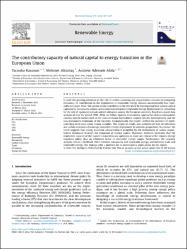| dc.contributor.author | Kassouri, Yacouba | |
| dc.contributor.author | Altuntaş, Mehmet | |
| dc.contributor.author | Alola, Andrew Adewale | |
| dc.date.accessioned | 2023-10-21T06:06:48Z | |
| dc.date.available | 2023-10-21T06:06:48Z | |
| dc.date.issued | 2022 | en_US |
| dc.identifier.issn | 0960-1481 | |
| dc.identifier.issn | 1879-0682 | |
| dc.identifier.uri | https://hdl.handle.net/11363/5995 | |
| dc.description.abstract | In spite the growing attention on the role of carbon capturing and sequestration schemes in mitigating
emissions, its contribution to the deployment of renewable energy remains uncomfortably low, especially in Europe. Thus, the current study contributes to the literature by investigating how natural capital
captured by biocapacity amidst carbon emission influences renewable energy deployment by controlling
for the role of openness to trade and oil utilization among the European countries. Based on a panel data
analysis of over the period 1990e2016, we follow rigorous econometric approaches that accommodates
country-specific factors such as the cross-sectional dependence, country-specific heterogeneity, and the
non-stationarity dimension of the variables. Fundamentally, the results confirm the presence of significant long-term association among variables. The empirical results also authenticate that oil utilization
and carbon emissions discourage renewable energy deployment by inelastic proportions. In essence, the
result suggests that energy transition advancement is propelled by the deployment of carbon sequestration techniques through the expansion of natural capital. Moreover, evidence illustrates that the
productive capacity of the Europe's ecosystem and openness to trade are critical to the region's energy
transition policy, thus an influential factor of renewable energy supply. Furthermore, the causality
analysis reveals a feedback effect between biocapacity and renewable energy, and between trade and
renewable energy. The findings offer a platform for re-invent policy implications for the region. | en_US |
| dc.language.iso | eng | en_US |
| dc.publisher | PERGAMON-ELSEVIER SCIENCE LTD, THE BOULEVARD, LANGFORD LANE, KIDLINGTON, OXFORD OX5 1GB, ENGLAND | en_US |
| dc.relation.isversionof | 10.1016/j.renene.2022.03.142 | en_US |
| dc.rights | info:eu-repo/semantics/openAccess | en_US |
| dc.rights | Attribution-NonCommercial-NoDerivs 3.0 United States | * |
| dc.rights.uri | http://creativecommons.org/licenses/by-nc-nd/3.0/us/ | * |
| dc.subject | Renewable energy | en_US |
| dc.subject | Biocapacity | en_US |
| dc.subject | Carbon emissions | en_US |
| dc.subject | Trade | en_US |
| dc.subject | Oil energy | en_US |
| dc.subject | European Union | en_US |
| dc.title | The contributory capacity of natural capital to energy transition in the European Union | en_US |
| dc.type | article | en_US |
| dc.relation.ispartof | Renewable Energy | en_US |
| dc.department | İktisadi İdari ve Sosyal Bilimler Fakültesi | en_US |
| dc.authorid | https://orcid.org/0000-0002-5423-8263 | en_US |
| dc.authorid | https://orcid.org/0000-0001-5355-3707 | en_US |
| dc.identifier.volume | 190 | en_US |
| dc.identifier.startpage | 617 | en_US |
| dc.identifier.endpage | 629 | en_US |
| dc.relation.publicationcategory | Makale - Uluslararası Hakemli Dergi - Kurum Öğretim Elemanı | en_US |
| dc.contributor.institutionauthor | Alola, Andrew Adewale | |



















